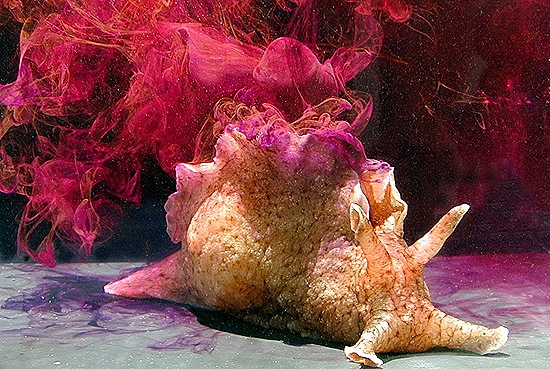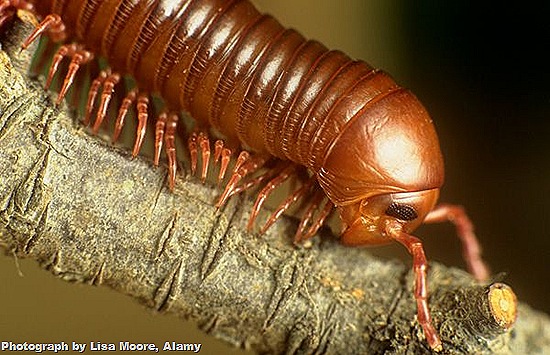
You’re chatting with someone you find bright and attractive when suddenly they lean a little closer and WHAM! You get hit with a whiff of monster breath. Nothing pulls the plug on attraction, even just social attraction, like a bad bouquet.
Plenty of animals will run a mile from a foul stench, too. While camouflage, tough skins, and fierce looks are among animals’ great defenses, these five species know that everyone runs from a big stink. (Also see “Top 5 Animal Defense Tactics.”)
1. Vulture
A king vulture at the Zoo Summit outside Panama City in June.
In Stand by Me, Stephen King describes a pie-eating contest that turns into “a complete and total barf-o-rama” when the winner intentionally vomits, moving the crowd to follow suit.
Vultures, too, know all about puke power. They are scavengers that feast on the rotting flesh of dead animals, which benefits us by ridding our highways and landscapes of carcasses and the bacteria they might carry. When vultures feel threatened they vomit, and the stink of barfed-on carcass puts off most predators.
What’s more, throwing up allows the vulture to fly away more quickly - and the vomit can sting the aggressor’s eyes and face.
It’s generally effective, except when the predator is more foul than the odour - like us. (See: “Elephant Poachers Poison Hundreds of Vultures to Evade Authorities.”)
2. Opossum
A Virginia opossum snarls.
In some ways opossums have it easy. In order to fake their own death, they don’t have to fax anyone a death certificate, chose a country to hide in, or look over their hairy shoulders for insurance investigators.
The critters just lie there with their tongues hanging out, sometimes for hours, effectively convincing potential predators they can find a much fresher meal elsewhere. Even if they keep getting attacked, they won’t move any more than a human statue or the Queen’s palace guard until the threat has passed.
As part of their performance fit for Hollywood, possums feigning death even emit a stench, pooping out “extra green smelly mucus,” according to the Wisconsin Department of Natural Resources.
Who smells an Oscar?
3. Hoatzin
Hoatzins on the Rio Napo in the Ecuadorian Amazon.
If you’re a bird, you’re among some of the world’s greatest singers, dancers, and show-offs. You have to have something mighty special to stand out in that crowd.
Hold your nose and meet the hoatzin, a bird with a number of distinctions, not the least of which is that it smells like fresh cow manure. The animal mostly eats leaves, which it digests in its crop, a pouch some birds have high up in their alimentary canal. It’s the only bird known to digest by fermentation, like a cow. This process is what causes its odour and has earned it the nickname the “stink bird.”
Don’t knock it, though. That stink means that even people don’t want to eat the hoatzin.
We give points for cleverness to the Cornell Birdscope website for their entry on this aromatic avian, headlined: Alimentary, My Dear Hoatzin!
4. Millipede
A millipede can produce hydrogen cyanide.
Millipedes are tricky. For starters they look wormy, but they’re not even insects - they’re arthropods, more closely related to crabs and spiders. Their name is deceptive, too: Their legs number about 750 (not the thousand you’d guess). Despite their horror movie appearance, they’re leaf eaters that don’t bite humans.
Millipedes have a number of predators, including lizards, birds, and insects, and one of their defenses is to curl up into a ball (which, ironically, makes them look better, even beautiful - at least, to this human eye). Some, though, also release a noxious defensive spray that can irritate skin, harm eyes, and leave a horrible odour on its assailant.
Paul Marek of the Department of Entomology at Virginia Tech told National Geographic that millipedes have about 30 different chemical secretions, so what you get depends on which type you encounter.
These secretions can include hydrogen cyanide. You might want to watch out for two of the cooler-looking ones: Apheloria virginiensis (which Marek says has a nice odour, like cherry cola) releases cyanide, and Narceus americanus releases benzoquinone that can stain your hands. Just ask our intrepid editor.
“Their defense secretions are really for smaller animals,” so if a bird picks them up they’ll get irritated and put them down. If you pick them up, it’s probably best just to wash your hands.
“They taste nasty,” said Marek, and yes, he tasted one - licked it, to be precise, and found it to be a “spicy, burning taste.”
Thanks to his scientific curiosity, we won’t look for a millipede recipe book any time soon…not even for Halloween.
5. Sea Hare
The sea hare releases a slimy ink.
The graceful sea hare is toxic in the first place, so it’s not the most popular dish in the sea food chain. Nonetheless, this type of sea slug has a pretty ingenious smell-related defense that is almost the opposite of its odiferous companions on this list. The sea hare secrets a slimy, purple ink that’s a mix of ink and opaline; a 2010 study showed that the substance makes food less palatable to predators.
Researchers noticed that lobsters who got blasted with sea hare ink displayed anxious behaviours like flipping their tails and rubbing their mouth parts. And a 2012 study using spiny lobsters as model predators found that the opaline in sea hare ink blocks the lobster’s chemoreceptors, so it can’t smell potential food.
In other words, the sea hare gives its antagonists the equivalent of a stuffy nose so they don’t know how delicious it smells.
Will we have to go to pun jail if we call this chemo-flage?
Top image: Aplysia californica, a typical sea hare displaying inking behaviour, via Wikimedia Commons.





Hi Alizul,
ReplyDeleteI am a journalism student with a keen interest in technology. I was hoping that after finishing my study I could work for one of the top news companies, I wish to expand my portfolio by writing on big sites. I would like to contribute an article on your great blog free of charge in order to provide you with some content, and perhaps it would help me expand my portfolio further.
I really enjoyed reading alizul2.blogspot and am not sure if you are open to guest post. I have some interesting ideas that I would like to share with you and your readers. I am certain you will enjoy it. Therefore, I hope I would be given the precious opportunity.
If you are interested in guest post, please contact me at ninokikira@gmail.com.
I am looking forward to hearing from you.
Many thanks,
Lenny
Dear Lenny,
ReplyDeleteSorry for the late reply. Please see my email which I've just sent. Thank you.
Alizul
Excellent post. I was checking constantly this blog and I'm impressed!
ReplyDeleteVery helpful info particularly the closing part :) I deal with such information much.
I was looking for this particular information for
a long time. Thanks and best of luck.
Also visit my blog post ... phone sex